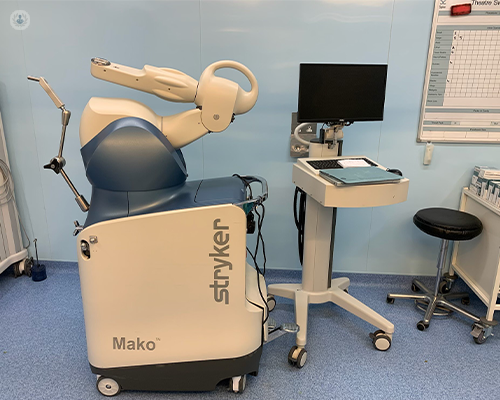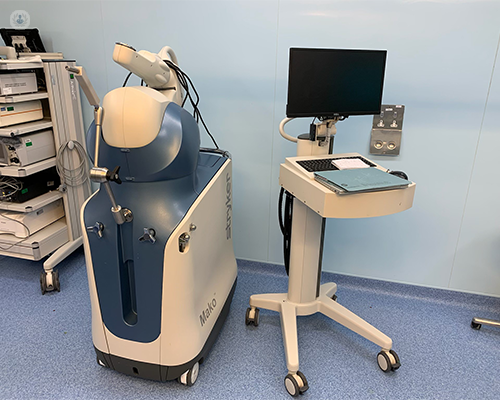Robotic knee surgery versus traditional methods
Escrito por:As technology is advancing more in our everyday lives, it is evolving how procedures are done in operating theatres. One of the more advanced in orthopaedics is robotic-assisted knee surgeries. Experienced consultant trauma and orthopaedic surgeon Mr Ash Gulati explains the newer procedure and how it compares to the traditional method.

What is robotic knee surgery vs traditional knee surgery?
In a traditional non-robotic knee replacement, including computer navigation surgery, the surgeon makes bony cuts using various guides based upon the information obtained from static investigations such as X-rays, CTs, and MRIs performed before the surgery.
On the other hand, with the robotic knee surgery, in addition to the static imaging data collected before surgery, dynamic assessments are made at the time of surgery while making bone cuts so that the procedure can be customised to each patient. This allows better prediction of soft tissue balance and tensioning of the surrounding ligaments and tendons.
What are the advantages of robotic knee surgery?
Robotic-assisted knee replacements are advancement over previous generation of knee replacements. Pre-op 3D imaging and planning is used to enhance the accuracy and permits to implant knee components tailor-made based on a patient’s individual anatomy.
In addition to allowing superior precision, robotic surgery is less invasive than conventional knee replacement with smaller incisions, and less disturbance to surrounding bone and tissue. Since the knee implant placement is more precise, it results in less friction and wear for the new components and less risks requiring future revision surgery.
How long does the robotic surgery take and how long is the recovery?
The actual surgery will last approximately one hour. Patients are permitted to walk soon after the procedure, and most are back to normal daily activities, such as driving a car, within two weeks. Unlike traditional nonrobotic-assisted approaches, Mako procedures require fewer soft tissue releases. This means there’s less pain and a faster recovery. And, because your surgeon can provide a better joint alignment using Mako technology, it can mean you walk more naturally, sooner.

Is robotic surgery more painful?
Due to advances in pain management techniques during your surgery as well as the Mako procedure itself, patients’ pain is significantly decreased compared to total knee replacements of years past. Since the surgery is less invasive than conventional knee replacement with smaller incisions and less disturbance to surrounding bone and tissue, patients experience less pain and faster healing, enabling them to return to normal activities much sooner.
Am I suitable for robotic knee surgery and will my insurance company cover it?
Robotic-assisted technology can be used for both partial and full knee replacements. Anyone with knee arthritis who hasn’t had a joint replacement before is a good candidate for Mako robotic-assisted surgery. Patients who need a previous joint replacement revised or redone are not suitable. Most insurance providers cover the robotic knee surgery as a standard, but you should double check with your insurance company to learn about your plan.
Are there any cons to robotic knee surgery?
The procedure takes slightly longer to perform than a conventional joint replacement so that all the extra checks and measurements are carried out. So, theoretically, the risk of infection could be slightly higher although this has not been proven in any scientific study so far. As ever, the computer system is only as good as the data it uses and the people who process it. So, it is important that only fully trained personnel are allowed to carry out robotic knee surgery.
The cost of the procedure is also slightly more than a conventional joint replacement because a pre-op CT scan is required to plan the procedure, but most insurance companies cover it as a part of the standard cover.
If you are having knee pain or are seeking to have a knee replacement, you can go to Mr Gulati’s profile and book a consultation.


